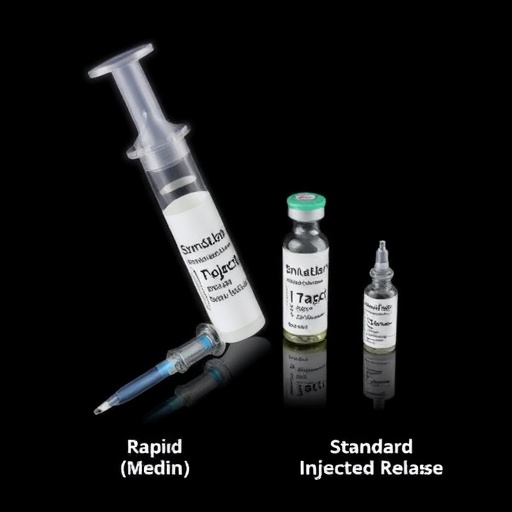In a groundbreaking multicenter randomized clinical trial published in JAMA Network Open, researchers have uncovered new insights into the optimization of buprenorphine induction protocols for patients grappling with opioid use disorder, particularly those exposed to fentanyl contamination. This study meticulously compared two induction strategies of extended-release buprenorphine injection, revealing vital information that could reshape clinical approaches to addiction management. The findings underscore the superiority of rapid induction in enhancing patient retention rates, a critical factor in achieving sustained recovery in opioid dependence.
Central to this investigation was the comparison between rapid induction and standard induction protocols. Rapid induction entails initiating treatment with methodological intensification that aims to promptly reach therapeutic drug levels. In contrast, standard induction follows a more gradual escalation of dosage and dosing intervals. The trial demonstrated that patients undergoing rapid induction exhibited notably higher retention rates than those following the standard protocol. This retention advantage was especially pronounced in patients who had tested positive for fentanyl, a synthetic opioid notorious for its high potency and association with overdose deaths.
The pharmacokinetic profile of extended-release buprenorphine administration was a pivotal aspect of the study. Injection 2, representing the second dose in the extended-release buprenorphine treatment regimen, was administered either after one week or after one month from the initial injection. The timing of this second injection is crucial, as it determines the maintenance of plasma buprenorphine concentrations above the therapeutic threshold. The study revealed that delivering injection 2 at one week post-initial dose was well tolerated by patients and provided a significant pharmacological advantage by minimizing durations during which plasma concentrations dipped below the targeted therapeutic minimum of 2 ng/mL.
Retention in medication-assisted treatment (MAT) programs is frequently hampered by periods wherein subtherapeutic drug levels expose patients to withdrawal symptoms or increased cravings, leading to dropout and relapse. The present research’s insight that a shortened inter-dose interval can substantially reduce the time patients spend below effective buprenorphine levels promises to enhance adherence and clinical outcomes. By mitigating these pharmacological vulnerabilities, clinicians can better support individuals striving to establish and maintain opioid abstinence.
The multicenter nature of this randomized clinical trial lends robustness to its conclusions. By enrolling participants across diverse clinical environments, the researchers ensured broad applicability of their findings. The study’s rigorous design and controlled randomization strengthened the validity of observed differences between rapid and standard induction strategies. Such methodological rigor is indispensable in disentangling the complex interactions between treatment regimens and patient outcomes in addiction medicine.
Fentanyl positivity among participants added an urgent clinical dimension to the study. The pervasive contamination of illicit opioid supplies with fentanyl has created a public health crisis due to the substance’s pronounced potency and rapid onset of action. Patients with fentanyl exposure often exhibit severe withdrawal symptoms and poor responses to traditional buprenorphine induction. The enhanced retention observed in fentanyl-positive patients following rapid induction suggests a tailored approach could be pivotal in managing this high-risk group.
Beyond clinical retention, the safety and tolerability of accelerated induction protocols are critical considerations. The trial’s findings that administering injection 2 at one week is well tolerated alleviate concerns about potential adverse effects from faster induction schedules. This observation supports adopting rapid induction protocols in real-world clinical settings without compromising patient safety, a factor that healthcare providers must weigh when structuring treatment plans.
The implications of this study extend to public health policy, where optimizing the delivery of medication-assisted treatment could serve as a linchpin in combating the opioid epidemic. By integrating rapid induction protocols that ensure steady therapeutic buprenorphine levels, treatment programs can expect improved patient engagement and reduced rates of relapse and overdose. This research provides empirical evidence supporting policy shifts favoring more aggressive induction schedules in MAT guidelines.
Technological advances in extended-release formulations of buprenorphine underpin the feasibility of such induction modifications. Extended-release injections offer a long-acting alternative to daily oral dosing, reducing the burden of medication adherence and stigma associated with frequent medication pickups. The study’s demonstration that timely administration of injection 2 enhances therapeutic coverage further validates the clinical utility of these long-acting preparations.
While the study offers promising data, it also opens new avenues for further research. Future investigations could explore optimal timing intervals customized to patient-specific factors such as metabolic profiles, severity of opioid dependence, and concomitant substance use. Moreover, understanding the mechanistic underpinnings behind improved retention with rapid induction may unravel pharmacodynamic variables critical for personalized addiction treatment.
The study’s detailed statistical analysis underscoring the significance of results adds a layer of confidence in its conclusions. Randomization procedures minimized selection biases, and outcome measures were defined with clinical precision. Detailing the retention outcomes, the study provides quantitative evidence that supports a strategic pivot in MAT protocols toward more rapid buprenorphine induction in at-risk populations.
In summary, this pioneering clinical trial elucidates key aspects of buprenorphine extended-release induction that can enhance therapeutic retention, particularly for fentanyl-exposed individuals. The evidence advocates for clinical adoption of rapid induction protocols with earlier dosing of subsequent injections to sustain therapeutic drug levels and improve treatment adherence. As the addiction treatment landscape evolves, these insights represent a vital contribution to the ongoing battle against opioid use disorder and its devastating societal impacts.
Subject of Research:
Article Title:
News Publication Date:
Web References:
References:
Image Credits:
Keywords: Drug therapy, Medications, Clinical trials, Randomization




